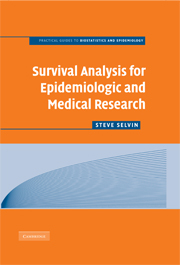Book contents
- Frontmatter
- Contents
- Overview
- 1 Rates and their properties
- 2 Life tables
- 3 Two especially useful estimation tools
- 4 Product-limit estimation
- 5 Exponential survival time probability distribution
- 6 Weibull survival time probability distribution
- 7 Analysis of two-sample survival data
- 8 General hazards model: parametric
- 9 General hazards model: nonparametric
- Examples of R
- Data
- Problem set
- References
- Index
5 - Exponential survival time probability distribution
Published online by Cambridge University Press: 03 February 2010
- Frontmatter
- Contents
- Overview
- 1 Rates and their properties
- 2 Life tables
- 3 Two especially useful estimation tools
- 4 Product-limit estimation
- 5 Exponential survival time probability distribution
- 6 Weibull survival time probability distribution
- 7 Analysis of two-sample survival data
- 8 General hazards model: parametric
- 9 General hazards model: nonparametric
- Examples of R
- Data
- Problem set
- References
- Index
Summary
A product-limit estimate of a survival probability is model-free. Thus, the resulting estimates do not depend on assumptions or require knowledge about the population that produced the sampled survival data. The value estimated is entirely determined by the data. A totally different approach requires that a specific parametric model describe the sampled population. The exponential survival time probability distribution is one such model. It is a simple but theoretical distribution that completely defines a survival probability based on a single parameter (denoted λ). Specifically, this survival function is
survival probability = P (T ≥ t) = S(t) = e-λt.
For example, for time t = 20 years, the survival probability is P (T ≥ 20) = S(20) = e-0.04(20) = 0.449 when the exponential distribution parameter is λ = 0.04 (Chapter 1, Figure 1.1). Thus, for a randomly sampled individual whose survival time is described by these exponential survival time data (λ = 0.04), the probability of surviving beyond time t = 20 years is 0.449. For any other value of t, the corresponding survival probability is similarly calculated. The survival time distribution depends entirely on a single parameter (in the example, λ = 0.04) to completely describe the population sampled. Figure 5.1 displays the geometry of three exponential survival functions (λ = 0.04, 0.15, and 1.0).
The exponential function f (x) = e-λx is found in a variety of contexts other than survival analysis. For example, it is used to describe the physics of heat loss from an object (Newton's law of cooling), the loss of electrical charge, the oscillations of a spring, and the interest accumulated in a bank account.
- Type
- Chapter
- Information
- Survival Analysis for Epidemiologic and Medical Research , pp. 90 - 110Publisher: Cambridge University PressPrint publication year: 2008



